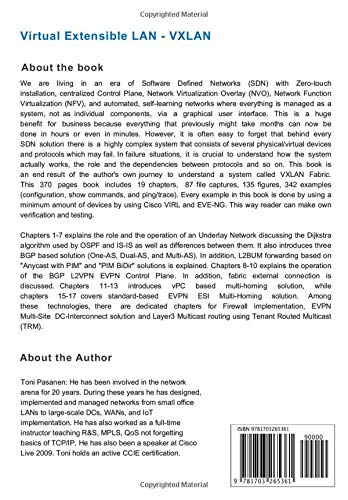All Categories



Virtual Extensible LAN (VXLAN): A Practical guide to VXLAN solution
Share Tweet
Get it between 2025-07-29 to 2025-08-05. Additional 3 business days for provincial shipping.
*Price and Stocks may change without prior notice
*Packaging of actual item may differ from photo shown
- Electrical items MAY be 110 volts.
- 7 Day Return Policy
- All products are genuine and original
- Cash On Delivery/Cash Upon Pickup Available








About Virtual Extensible LAN (VXLAN): A Practical Guide
We are living in an era of Software Defined Networks (SDN) with Zero-touch installation, centralized Control Plane, Network Virtualization Overlay (NVO), Network Function Virtualization (NFV), and automated, self-learning networks where everything is managed as a system, not as individual components, via a graphical user interface. This is a huge benefit for business because everything that previously might take months can now be done in hours or even in minutes. However, it is often easy to forget that behind every SDN solution there is a highly complex system that consists of several physical/virtual devices and protocols which may fail. In these situations, it is crucial to understand how the system actually works, the role and the dependencies between protocols and so on. This book is an end-result of the author's own journey to understand a system called VXLAN Fabric. This 370 pages book includes 19 chapters, 87 file captures, 135 figures, 342 examples (configuration, show commands, and ping/trace). Every example in this book is done by using a minimum amount of devices by using Cisco VIRL and EVE-NG. This way reader can make own verification and testing.Chapters 1-7 explains the role and the operation of an Underlay Network discussing the Dijkstra algorithm used by OSPF and IS-IS as well as differences between them. It also introduces three BGP based solution (One-AS, Dual-AS, and Multi-AS). In addition, L2BUM forwarding based on "Anycast with PIM" and "PIM BiDir" solutions is explained. Chapters 8-10 explains the operation of the BGP L2VPN EVPN Control Plane. In addition, fabric external connection is discussed. Chapters 11-13 introduces vPC based multi-homing solution, while chapters 15-17 covers standard-based EVPN ESI Multi-Homing solution. Among these technologies, there are dedicated chapters for Firewall implementation, EVPN Multi-Site DC-Interconnect solution and Layer3 Multicast routing using Tenant Routed Multicast (TRM).



















